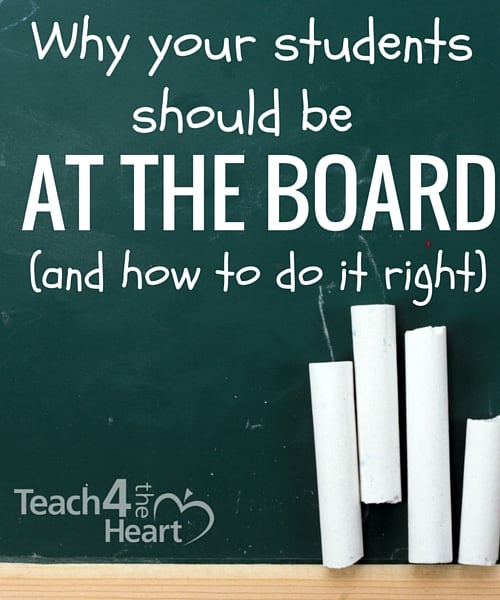“Can I please put up a problem?”
“If anyone’s absent, can I do theirs?”
“I got #5. Can I do it?”
My sixth grade math class greets me with a torrent of questions whenever we start class. Although it’s slightly overwhelming, I’m encouraged by their enthusiasm.
While not all ages respond with this much excitement at the prospect of doing math problems in front of the class, they can all benefit from being called down to the board.
While students can work at the board for a variety of reasons, one of the best times for this is for checking & reviewing assignments such as homework or classwork.
Why Your Students Should Be at the Board
- It keeps them accountable. It’s pretty easy to tell which students did their work when you ask them to put the answer on the board.
- Explaining an answer builds higher-level skills. Having students put problems on the board is about much more than just what they write. You should be having them explain their problem or question to the class. Explaining how they found an answer requires higher-level thinking skills and helps students get a better grasp on the concept itself.
- You get a better idea of how well students understand the concepts. Sometimes students arrive at the correct answer but still have some misconceptions in their logic. When you hear a student explain how they got their answer, you can spot & correct these misconceptions.
- The students are the ones working (and thus learning). I’m sure you’ve heard the saying “the one who is working is the one who is learning.” When you (the teacher) just read the answers or work the problems yourself, the students may or may not be paying attention, but at best they’re just watching you. However, when they put up the problems and explain them, they are actively involved and thus much more engaged.
- You save time. It’s a lot faster for the students to put multiple questions on the board at once than for you to work through them one by one.
- Students develop their public speaking skills. Public speaking is a vital life skill, and we can help them overcome their public-speaking fears by requiring them to explain problems to the class on a regular basis. It soon becomes no big deal, and students get more comfortable speaking in front of a group.
I hope you’re seeing the benefits of having your students demonstrate answers at the board, but you may be wondering about the logistics.
The logistics are key to this process. Good organization & procedures will make this smooth and effective….as opposed to trying it haphazardly, which just might be a disaster.
How To Do It Right
Let’s discuss a recommended procedure for going over homework at the start of class. This can obviously be modified for classwork or other activities.
- Write a student’s name on the board for each question. Before class starts, determine which student will present each question and write their name & the number of the question on the board. Leave enough space so that the student can write the problem underneath their name.
- Have the students write their answers (& any work) on the board while the rest of the class does bellwork. When your students enter class, teach them to start on a bellwork assignment. Those students whose names are on the board are to put up the problem while the rest of the class works on the start-of-class assignment. (See my post “How to Start Class Without the Chaos” for more details.)
- Exchange and grade the bellwork and homework. Quickly read the answers to the bellwork (exchange & grade if you’d like). Turn in the bellwork or put it away. Next, if you want to take homework for a grade, exchange & grade it before you go over the problems. Just quickly read the answers; don’t explain anything right now. (If you want to see how I grade homework, check out this article here.)
- Have the students present their problems to the class one at a time. Train your students to follow this procedure: The first three students go to the board – two of which stand off to the side while the first explains his problem. After he explains it, you ask the class if they have any questions. Try to refer any questions back to the student, or you can answer them yourself if needed. If the answer is incorrect, help the student and/or the class determine the right answer. When that student is finished, he should erase his problem and sit down. As you move on to the next question, the 4th student should come up to the front so that three students are always at the board at any given time. Continue this process until all the problems have been explained and discussed.
A note about procedures: It’s important to practice procedures, not to just tell them. Read this article here for tips about how to teach procedures so that your students will actually follow them.
Middle school math teachers: If you need a bellwork assignment, grab this free set of middle school math bell ringers.
Do your students explain work at the board? Why or why not?



I am the only math teacher in my school that sends the students to the board. They love it and I am able to provide immediate feedback. It is such a simple way to assess my students.
I would ensure that the student feels comfortable with their answer before they are sent to the board, especially, those students who may feel anxious or insecure about their ability to do Math well, this type of pedagogic technique made me petrified of math, and was made fun of for not reaching the right answer. That was fun as a 5th grade student…